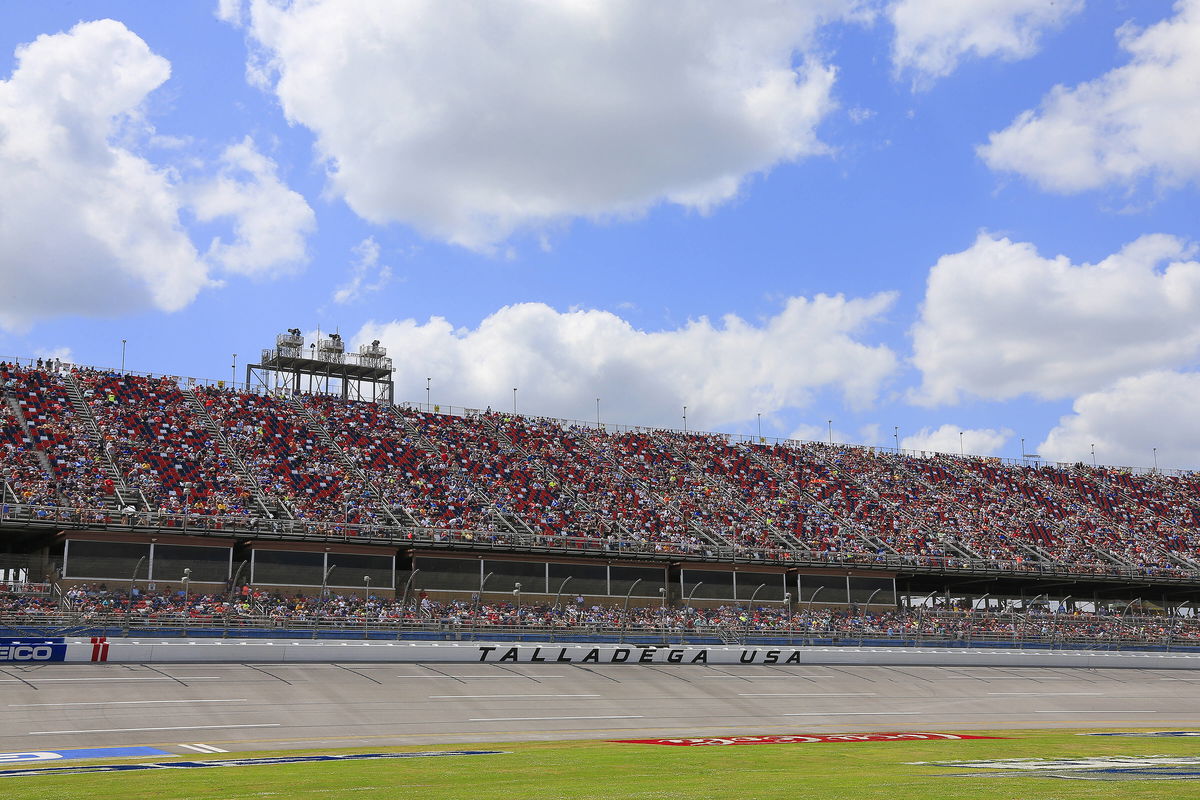
Imago
TALLADEGA, AL – APRIL 24: Blue skies and white clouds were in abundance for the running of the NASCAR, Motorsport, USA Cup Series GEICO 500 race on April 24, 2022 at the Talladega Superspeedway in Talladega, Alabama. Photo by David J. Griffin/Icon Sportswire AUTO: APR 24 NASCAR Cup Series GEICO 500 Icon9532204241030500

Imago
TALLADEGA, AL – APRIL 24: Blue skies and white clouds were in abundance for the running of the NASCAR, Motorsport, USA Cup Series GEICO 500 race on April 24, 2022 at the Talladega Superspeedway in Talladega, Alabama. Photo by David J. Griffin/Icon Sportswire AUTO: APR 24 NASCAR Cup Series GEICO 500 Icon9532204241030500
“When there’s a will, there could be a way,” goes the saying. But tall hopes collide with harsh realities at Talladega Speedway. When veteran reporter Bob Pockrass was asked about Talladega ever installing lights, he laid it out straight, saying, “You’d never plan to have a night race,” because the project would have to cover the entire facility and even budget for an insurance policy.
Watch What’s Trending Now!
In other words, it’s not something magical that’s stopping Talladega from shining on after sunset; it’s the price tag and logistics. Talladega’s fans may dream of drafting under the stars, but Pockrass’s blunt analysis reminds us that for a track in the middle of nowhere, night racing is technically possible yet financially and operationally prohibitive.
ADVERTISEMENT
The high cost of lights and the road to night racing
Lighting a NASCAR superspeedway isn’t just about adding a few headlights; it’s a huge construction project with a monumental bill. Longtime industry observers estimate that installing lights “around the massive property” of Talladega would cost “several tens of millions of dollars.” For comparison, Martinsville Speedway’s half-mile was the first in NASCAR to be lit by LED in 2017 at a price of roughly $5 million.
Even Michigan‘s two-mile oval shuddered at the thought. In 2016, its president said lighting the track and the surrounding roads would run about $17 million. Talladega’s 2.66-mile tri-oval is even bigger and sits farther from power lines, so one can imagine the cost stacking up. To put it in perspective, Daytona’s 2016 renovation, which included new lights, was a $400 million project.
Where there is a will, there could be a way. But it would be massively expensive not only to light up the track but all the parking lots as well as the roads here are dark. And it’s not like this area would want other night events. Plus Talladega at night is about the party. https://t.co/qfj4ywyJFQ
— Bob Pockrass (@bobpockrass) October 18, 2025
ADVERTISEMENT
Any way you slice it, multiple millions would have to be sunk into poles, LED fixtures, cabling, and switchgear to make Talladega glow. And that’s just the start of the expense ledger.
ADVERTISEMENT
Engineering and infrastructure: powering the night
Even if the funds were allocated, the technical hurdles are stark. Talladega Superspeedway sits deep in rural Alabama, and as Pockrass noted, the local electrical grid “just couldn’t handle the load” of a night race. To make the lights work, Alabama Power would have to install major new substations, transformers, and high-voltage lines, effectively building a mini power plant dedicated to a few weekends of racing a year.
And the red tape doesn’t stop there. Talladega is flanked by tall floodlights and an adjacent municipal airport, meaning any new lighting scheme would have to avoid blinding pilots or violating Federal Aviation Administration rules. Indeed, experts point out that motorsports lighting systems from companies like Musco are custom-designed to meet exacting standards, and Talladega’s design would rival Daytona‘s in scale.
ADVERTISEMENT
Racing the clock: sunshine vs. floodlights
For now, Talladega deals with darkness most simply: it races in the daylight. There’s no permanent lighting, so NASCAR schedules Talladega events earlier in the day to avoid sunset. In fact, even the Truck Series learned this lesson.
A 2025 preview noted plainly that “Talladega does not have lights, so this race must start earlier to account for the looming darkness.” This pragmatic approach means fans get full races in sunshine, but it’s a far cry from the spectacle of a floodlit Talladega finish.

Imago
NASCAR, Motorsport, USA Xfinity: Ag-Pro 300 Apr 26, 2025 Talladega, Alabama, USA NASCAR Cup Series driver Ross Chastain 1 leads going into turn one at Talladega Superspeedway. Talladega Talladega Superspeedway Alabama USA, EDITORIAL USE ONLY PUBLICATIONxINxGERxSUIxAUTxONLY Copyright: xJasonxAllenx 20250427_sjb_to8_268
Smaller stopgaps have been suggested, but these aren’t viable for Cup races. They would need dozens of huge diesel generators and cranes to cover the 2.66-mile circuit, and even then, TV broadcasters would prevent uneven lighting. And as Pockrass stressed, when it’s all said and done, the track and county would have spent a fortune just for a handful of dark sky laps, raising the inevitable question of whether it’s “the best use of $$$.”
ADVERTISEMENT
A tradition of daylight and decisions
All told, a Talladega night race remains a pipe dream. In recent years, the track has invested heavily in other upgrades. For example, a new infield fan pavilion and garage area touted as a $50 million transformation, but none of that budget is earmarked for lights.
ADVERTISEMENT

Imago
NASCAR, Motorsport, USA Xfinity: Ag-Pro 300 Apr 26, 2025 Talladega, Alabama, USA The pack of drivers comes around turn four at Talladega Superspeedway. Talladega Talladega Superspeedway Alabama USA, EDITORIAL USE ONLY PUBLICATIONxINxGERxSUIxAUTxONLY Copyright: xJasonxAllenx 20250427_sjb_to8_150
Track officials know the Alabama Speedway’s appeal lies partly in its tailgate parties and sunny afternoons; converting it into another Charlotte or Martinsville isn’t on the near-term agenda. Until some underwrites the immense cost of wiring up miles of highway and fan lots, Talladega’s scheduled races will continue to race toward sundown, not moonrise.
For now, NASCAR’s biggest draft cannot overcome Earth’s rotation, and Talladega’s legendary races will keep being won and lost by the sun.
ADVERTISEMENT
ADVERTISEMENT
ADVERTISEMENT
ADVERTISEMENT

